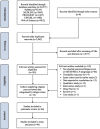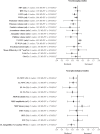Neurostructural and Neurophysiological Correlates of Multiple Sclerosis Physical Fatigue: Systematic Review and Meta-Analysis of Cross-Sectional Studies
- PMID: 33961198
- PMCID: PMC9381450
- DOI: 10.1007/s11065-021-09508-1
Neurostructural and Neurophysiological Correlates of Multiple Sclerosis Physical Fatigue: Systematic Review and Meta-Analysis of Cross-Sectional Studies
Abstract
Fatigue is one of the most debilitating symptoms for people with multiple sclerosis (PwMS). By consolidating a diverse and conflicting evidence-base, this systematic review and meta-analysis aimed to gain new insights into the neurobiology of MS fatigue. MEDLINE, ProQuest, CINAHL, Web of Science databases and grey literature were searched using Medical Subject Headings. Eligible studies compared neuroimaging and neurophysiological data between people experiencing high (MS-HF) versus low (MS-LF) levels of perceived MS fatigue, as defined by validated fatigue questionnaire cut-points. Data were available from 66 studies, with 46 used for meta-analyses. Neuroimaging studies revealed lower volumetric measures in MS-HF versus MS-LF for whole brain (-22.74 ml; 95% CI: -37.72 to -7.76 ml; p = 0.003), grey matter (-18.81 ml; 95% CI: -29.60 to -8.03 ml; p < 0.001), putamen (-0.40 ml; 95% CI: -0.69 to -0.10 ml; p = 0.008) and acumbens (-0.09 ml; 95% CI: -0.15 to -0.03 ml; p = 0.003) and a higher volume of T1-weighted hypointense lesions (1.10 ml; 95% CI: 0.47 to 1.73 ml; p < 0.001). Neurophysiological data showed reduced lower-limb maximum voluntary force production (-19.23 N; 95% CI: -35.93 to -2.53 N; p = 0.02) and an attenuation of upper-limb (-5.77%; 95% CI:-8.61 to -2.93%; p < 0.0001) and lower-limb (-2.16%; 95% CI:-4.24 to -0.07%; p = 0.04) skeletal muscle voluntary activation, accompanied by more pronounced upper-limb fatigability (-5.61%; 95% CI: -9.57 to -1.65%; p = 0.006) in MS-HF versus MS-LF. Results suggest that MS fatigue is characterised by greater cortico-subcortical grey matter atrophy and neural lesions, accompanied by neurophysiological decrements, which include reduced strength and voluntary activation. Prospero registration Prospero registration number: CRD42016017934.
Keywords: Fatigue; Multiple sclerosis; Neuroimaging; Neurophysiology; Neurostructural.
© 2021. The Author(s).
Conflict of interest statement
The authors declare that there are no conflicts of interest.
Figures



References
-
- Bisecco, A., Nardo, F.D., Docimo, R., Caiazzo, G., d'Ambrosio, A., Bonavita, S., Capuano, R., Sinisi, L., Cirillo, M., Esposito, F., Tedeschi, G., & Gallo, A. (2017). Fatigue in multiple sclerosis: the contribution of resting-state functional connectivity reorganization. Multiple Sclerosis Journal, 1352458517730932. - PubMed
Publication types
MeSH terms
LinkOut - more resources
Full Text Sources
Other Literature Sources
Medical
Research Materials
Miscellaneous

